Maximize Your Score in the 2025 Ramsay Maintenance Test: Free Practice Test for Exam Success
- Overview
- Quiz
- Sample Questions
- Curriculum
- Reviews
Prepare for the Ramsay Maintenance Test used by employers to test skills for Facilities Maintenance and Maintenance Planning/Preventative Maintenance positions. Our practice tests simulate the exam format, covering troubleshooting, repair techniques, equipment maintenance, and safety protocols. Whether you’re experienced or new to maintenance, practice with confidence to excel in your career. Start preparing now!

Complete Ramsay Maintenance Prep
Last Updated: Jan 07, 2025
Course Content
-
1Intro to ElectricityBuy this Course: Get full access to all lessons, practice tests and guides.
-
2Schematics & Print ReadingBuy this Course: Get full access to all lessons, practice tests and guides.
-
3HVAC and RefrigerationBuy this Course: Get full access to all lessons, practice tests and guides.
-
4Fluid Systems & PlumbingBuy this Course: Get full access to all lessons, practice tests and guides.
-
5Construction ProcessBuy this Course: Get full access to all lessons, practice tests and guides.
-
6Building and Finishing
-
7Repair and MaintenanceBuy this Course: Get full access to all lessons, practice tests and guides.
-
8Maintenance ManagementBuy this Course: Get full access to all lessons, practice tests and guides.
-
9Basic MechanicsBuy this Course: Get full access to all lessons, practice tests and guides.
-
10Maintenance Technician Test Final QuizzesBuy this Course: Get full access to all lessons, practice tests and guides.
-
11BONUS Interview Prep Video GuideBuy this Course: Get full access to all lessons, practice tests and guides.
What is Ramsay Maintenance Test (MainTest)?
The Ramsay Maintenance Test, created by Ramsay Corporation, is used by employers to assess the maintenance skills of candidates seeking roles in Facilities Maintenance and Maintenance Planning/Preventative Maintenance.
This test serves as a tool for organizations to gauge an individual’s proficiency and knowledge in various aspects of maintenance work, including but not limited to troubleshooting, repair techniques, equipment maintenance, preventive maintenance strategies, and adherence to safety protocols.
The test helps employers to effectively assess the competency and suitability of candidates for maintenance-related roles, aiding in the selection process and ensuring that the most qualified individuals are chosen for the positions.
Ramsay Maintenance Practice Test
Ramsay Maintenance Test: Levels & Format
The Ramsay MainTest is of two types one is for Facilities Maintenance and the other is for Maintenance Planning/Preventative Maintenance. These test variants are specifically designed to assess and evaluate distinct areas of maintenance expertise. Both these test are deigned to test candidates with 2-5 years of experience in the domain.
These tests are conducted in both offline and online formats, and the format you will face depends on the specific requirements and arrangements made by your hiring organization.
Facilities Maintenance Ramsay MainTest
The Facilities Maintenance Ramsay MainTest includes specific tests for different job profiles in non-manufacturing facilities. It assesses the skills and knowledge needed for maintenance roles in facility management and related areas, helping employers make informed hiring decisions.
BldgTest: This is a 60-question multiple-choice test designed to assess general maintenance skills in candidates for job roles in non-manufacturing facilities like schools, hospitals, and office buildings.
Facilities Maintenance Technician Test: Facilities Maintenance Technician: This 60-question multiple-choice test is specifically designed for employers assessing general maintenance skills in candidates for manufacturing facilities, such as automobile assembly plants, food processing plants, pharmaceutical manufacturing facilities etc.
Air Conditioning Specialist Test: Air Conditioning Specialist: This assessment is ideal for employers seeking to evaluate more specific and targeted skills in any type of facility. It consists of 60 multiple-choice items, allowing a comprehensive assessment of candidates’ knowledge and expertise.
Refrigeration Mechanic Test: This assessment is specifically tailored for employers looking to assess the skills of candidates in the field of refrigeration. It offers a comprehensive evaluation with 130 multiple-choice items, providing a thorough examination of candidates’ knowledge and proficiency in refrigeration mechanics.
Refrigeration (Ammonia Refrigeration) Test: This assessment is designed for employers seeking to evaluate candidates’ expertise in ammonia refrigeration. It consists of 100 multiple-choice items, providing a comprehensive evaluation of candidates’ knowledge and proficiency in this specialized field of refrigeration.
Building Electrician Test: This assessment is tailored for employers looking to evaluate candidates’ skills in building electrical systems. With 60 multiple-choice items, it provides a comprehensive evaluation of candidates’ knowledge and proficiency in various aspects of building electrical work.
Maintenance Planning/Preventative Maintenance
These tests are designed to cater to specific job profiles in the field of maintenance planning and preventative maintenance, particularly in non-manufacturing facilities. This test helps employers evaluates candidates’ skills and knowledge in areas of maintenance scheduling, preventive maintenance strategies, and overall maintenance planning.
There are further sub types:
Maintenance Planner Test: This comprehensive test is ideal for employers seeking to assess candidates’ planning and coordinating skills in maintenance. With 60 questions in a multiple-choice format, it effectively evaluates candidates’ abilities to plan and coordinate maintenance projects.
Maintenance Manager Test: This comprehensive assessment is ideal for employers seeking to evaluate candidates for positions that require practical mechanical and electrical job knowledge, along with strong leadership skills. With 60 multiple-choice items, this test provides a thorough evaluation of candidates’ proficiency in practical maintenance knowledge, electrical expertise, and leadership capabilities.
Project Engineer Test: This comprehensive assessment is specifically designed for employers hiring candidates for plant engineer positions that necessitate a combination of technical expertise and project management knowledge. With 46 multiple-choice items, this test offers a thorough evaluation of candidates’ proficiency in technical skills and project management capabilities.
Vibration Analysis Test: This specialized assessment is ideal for employers seeking to hire candidates for positions that involve vibration-based predictive maintenance. With 32 multiple-choice items, this test provides a focused evaluation of candidates’ proficiency in vibration analysis techniques and their application to predictive maintenance.
Ramsay MainTest Question Types [With Examples]
Print Reading
Print Reading is an important skill for professionals in various categories such as BldgTest, Facilities Maintenance Technician, Air Conditioning Specialist, and Refrigeration Mechanic. It involves interpreting and understanding construction blueprints, technical drawings, and diagrams. Proficiency in print reading allows individuals to accurately visualize and comprehend the specifications, dimensions, and details of a project or system. This skill is essential for planning, executing, and troubleshooting various maintenance tasks and installations.
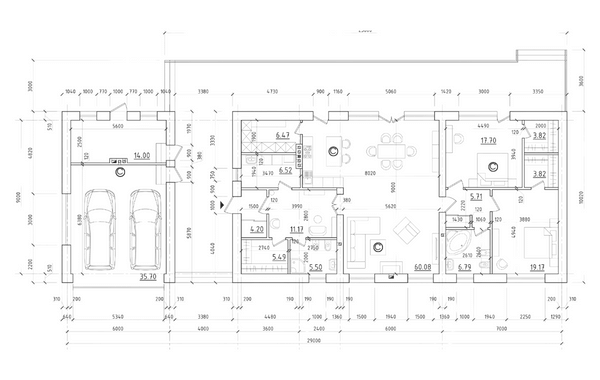
-
A:
Electrical Conduit
-
B:
Carbon Monoxide Detector
-
C:
Cooling Vent
-
D:
Communication cable
Explanation:
In construction blueprints, the symbol "C" with a circle around it is commonly used to represent carbon monoxide detectors. It helps maintenance technicians, electricians, and installers understand the planned placement and configuration of fixtures in a facility.
HVAC (Heating, Ventilation, and Air Conditioning)
This question category is applicable to BldgTest, Facilities Maintenance Technician, Air Conditioning Specialist, and Refrigeration Mechanic assessments. It focuses on assessing knowledge and skills related to HVAC systems, including principles, components, troubleshooting, and maintenance. Proficiency in HVAC is crucial for ensuring optimal comfort, energy efficiency, and functionality in various building environments.
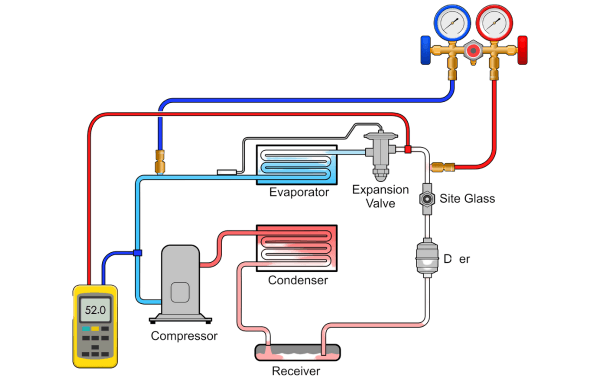
-
A:
To regulate the airflow in the ductwork
-
B:
To control the temperature level in the space
-
C:
To adjust the refrigerant flow rate and pressure
-
D:
To monitor the temperature of the cooling coil
Explanation:
An expansion valve is a vital component in an HVAC refrigeration system. Its primary purpose is to regulate the flow rate and pressure of the refrigerant as it enters the evaporator coil. By controlling the refrigerant flow, the expansion valve ensures proper cooling and heat absorption in the evaporator, facilitating the refrigeration cycle and maintaining optimal system performance.
Electrical
This category of questions applies to BldgTest, Facilities Maintenance Technician, Air Conditioning Specialist, Refrigeration Mechanic, and Refrigeration (ammonia refrigeration) assessments. It focuses on assessing knowledge and skills related to electrical systems, components, and troubleshooting. Proficiency in electrical concepts and practices is essential for maintaining, repairing, and ensuring the safe operation of various equipment and systems.
-
A:
High circuit impedance
-
B:
Power factor correction devices
-
C:
Power electronic devices like converters and inverters
-
D:
Overloading of transformers
Explanation:
Non-linear loads, such as power electronic devices (converters, inverters, etc.), can cause Total Harmonic Distortion (THD). These devices draw non-sinusoidal current from a sinusoidal voltage supply, causing distortion in the wave shape, which in turn results in the production of harmonic currents and voltages.
Plumbing & Piping
This question category applies to BldgTest, Facilities Maintenance Technician, and Air Conditioning Specialist assessments. It focuses on assessing knowledge and skills related to plumbing systems, piping installations, and maintenance. Proficiency in plumbing and piping is essential for ensuring proper water supply, drainage, and system functionality in various building environments.
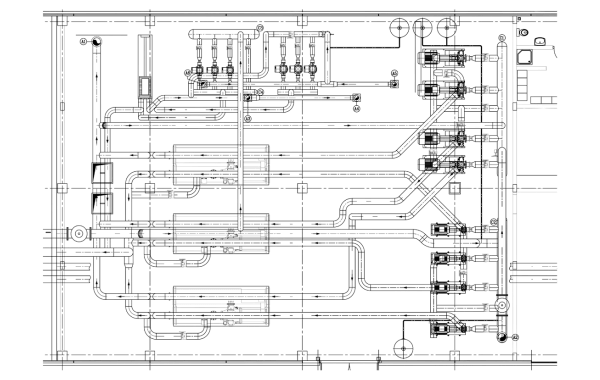
-
A:
The use of lowest possible pump pressure
-
B:
The use of highest possible water temperature
-
C:
The prioritization of natural convection over forced convection
-
D:
The balancing of flow rates across different branches of the system
Explanation:
Hydronic heating systems, which use water to transfer heat, require careful balancing to ensure even heat distribution across large commercial buildings. Balancing involves adjusting flow rates across different branches of the system so that each area receives an appropriate amount of heated water based on its specific heating requirements. This process promotes system efficiency and energy conservation.
Auxiliary Systems
This question category applies to the Facilities Maintenance Technician assessment. It focuses on assessing knowledge and skills related to auxiliary systems, which include various supporting systems and equipment in a facility. Proficiency in auxiliary systems is crucial for effectively maintaining and troubleshooting different components that contribute to the overall functionality and efficiency of a building.
-
A:
The fire alarm system may malfunction
-
B:
The sprinkler heads may not activate during a fire
-
C:
The fire suppression system may trigger unintentionally
-
D:
The sprinkler pipes may corrode more quickly
Explanation:
A wet pipe sprinkler system is constantly filled with pressurized water. The sprinkler heads are designed to activate when the heat from a fire causes a glass bulb or fusible link to break, which releases the water pressure and allows water to flow. If the air pressure in the system is significantly lower than the water pressure, it can result in an imbalance that might prevent the sprinkler heads from activating properly during a fire.
Welding
This question category applies to categories like Air Conditioning Specialist, Refrigeration Mechanic, and Refrigeration (ammonia refrigeration). It focuses on assessing knowledge and skills related to welding processes, techniques, and safety practices. Proficiency in welding is crucial for effectively joining and fabricating metal components in various applications.
-
A:
Higher interpass temperature increases tensile strength
-
B:
Lower interpass temperature increases ductility
-
C:
Higher interpass temperature reduces the chances of hydrogen-induced cracking
-
D:
Interpass temperature has no impact on mechanical properties
Explanation:
Interpass temperature is the temperature of the previously welded pass before the next pass is deposited. Maintaining a higher interpass temperature when welding high strength low alloy steels can help to reduce the risk of hydrogen-induced cracking.
Lubrication
This category of questions apply to the Refrigeration Mechanic assessment. It focuses on assessing knowledge and skills related to lubrication principles, practices, and maintenance. Proficiency in lubrication is essential for ensuring the proper functioning and longevity of various mechanical components in refrigeration systems.
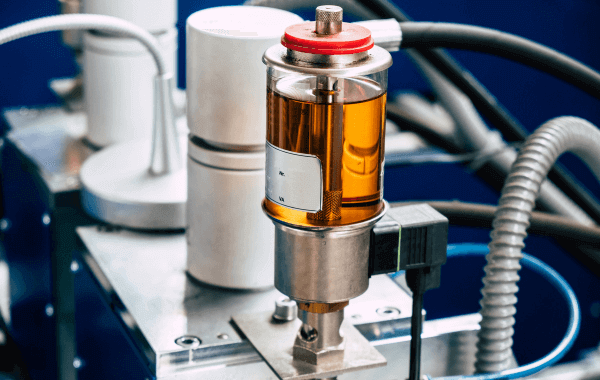
-
A:
Shear stability
-
B:
Oxidation resistance
-
C:
Low-temperature performance
-
D:
High-temperature performance
Explanation:
Viscosity index improvers are polymer additives that are used to reduce the rate of change of viscosity with temperature in lubricants. While they can improve the high-temperature and low-temperature performance of a lubricant and its shear stability, they typically do not have a significant effect on the lubricant's oxidation resistance, which is mainly determined by the base oil and antioxidant additives.
Burning & Heat-Treating
This category of questions apply to the Refrigeration Mechanic and Refrigeration (ammonia refrigeration) tests. It focuses on assessing knowledge and skills related to burning processes, heat treatment techniques, and safety precautions. Proficiency in burning and heat-treating is crucial for effectively working with metals and ensuring proper operation and maintenance of refrigeration systems.

-
A:
Martensite
-
B:
Bainite
-
C:
Pearlite
-
D:
Sorbite
Explanation:
Austempering is a heat treating process for steel or iron, in which the metal is quenched from the austenitizing temperature to a temperature just above the martensite start (Ms) temperature, and held in this temperature range until the austenite is completely transformed to bainite. This process produces a bainitic microstructure which is tougher, more ductile, and more stress resistant compared to conventional quench-and-temper structures.
Pneumatics
This category applies to the Refrigeration Mechanic and Refrigeration (ammonia refrigeration) assessments. It focuses on assessing knowledge and skills related to pneumatic systems, components, and troubleshooting. Proficiency in pneumatics is crucial for effectively working with compressed air systems and pneumatic equipment commonly used in refrigeration applications.
-
A:
To prevent the compressor from overheating
-
B:
To ensure the efficient conversion of ammonia from a gas to a liquid
-
C:
To keep the pneumatic actuators from moving too quickly
-
D:
To avoid unnecessary system noise
Explanation:
In an ammonia refrigeration system, maintaining the correct pressure is crucial to ensure the efficient conversion of ammonia from a gas to a liquid, which is essential for the refrigeration cycle. If the pressure isn't correctly controlled, the system may not cool effectively, leading to inefficiency in the refrigeration process.
General Repair & Maintenance
Questions of this type apply to the BldgTest, Facilities Maintenance Technician, and Air Conditioning Specialist assessments. It focuses on assessing knowledge and skills related to general repair and maintenance tasks commonly encountered in non-manufacturing facilities. Proficiency in general repair and maintenance is crucial for effectively addressing various maintenance issues and ensuring the overall functionality and safety of the facility.
-
A:
Increase the set temperature on the HVAC system.
-
B:
Check the building's insulation and identify any thermal bridges.
-
C:
Check and recalibrate the humidity sensors connected to the BMS.
-
D:
Replace the windows with double-glazed ones.
Explanation:
The first step should be to verify the accuracy of the humidity sensors. The BMS relies on these sensors to control the HVAC system, and if the sensors are providing inaccurate readings, the HVAC system won't respond correctly, leading to inconsistent humidity levels.
Carpentry
The questions for carpenters differ from the other Ramsay Maintests as they focus specifically on evaluating the knowledge and skills required for a carpenters role in non-manufacturing organisations. The test analyses skills around construction, installation, and repair of wooden work. Proficiency in carpentry ensures precise measurements, accurate cuts, and proper assembly of materials, resulting in high-quality finished products.
-
A:
Slowly increasing the temperature throughout the seasoning process.
-
B:
Rapidly drying the timber to speed up the seasoning process.
-
C:
Stacking the timber in layers separated by stickers for air-drying.
-
D:
Soaking the timber in water to reduce moisture content.
Explanation:
To prevent warping of timber during the seasoning process, it's best to stack the timber in layers separated by small pieces of wood known as 'stickers'. This allows for even air circulation, facilitating a uniform drying process and reducing the likelihood of the timber warping.
Tips to Ace the Ramsay MainTest
To prepare for the Ramsay MainTest: understand the test structure and time limits, review relevant concepts, practice time management, use sample questions, enhance problem-solving skills, seek feedback, and stay calm and focused.
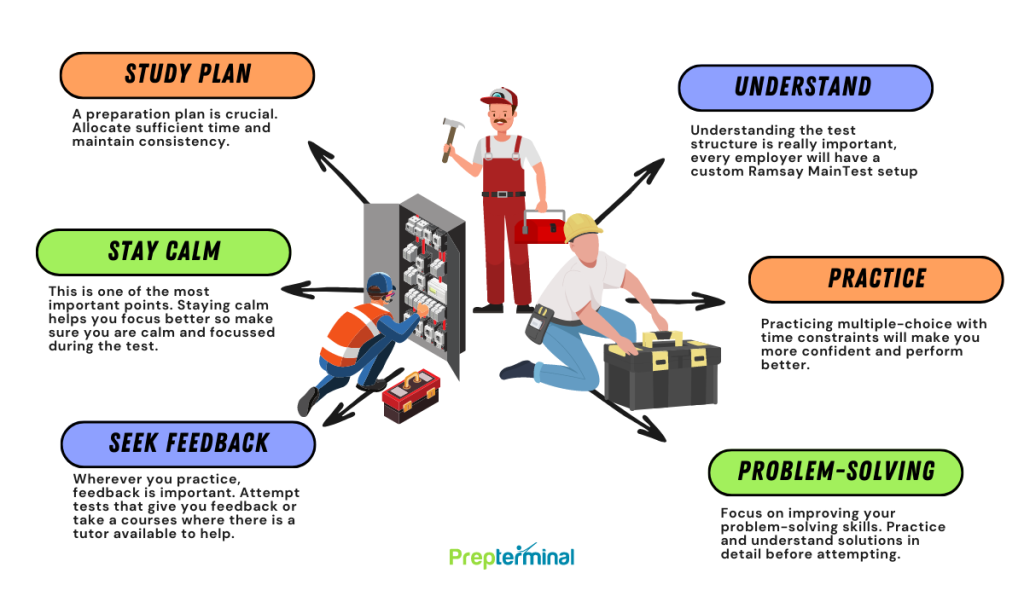

Created by: Michael Lerner
BSc, Psychometric Tutor, Prepterminal Test Expert
7869 students, 4.8, 1432 Reviews
Hey, I’m Michael, PrepTerminal’s Ramsay Maintenance Tests expert. I am here to help you with any questions or concerns you may have about the Ramsay Maintenance Tests. Feel free to contact me at [email protected].
